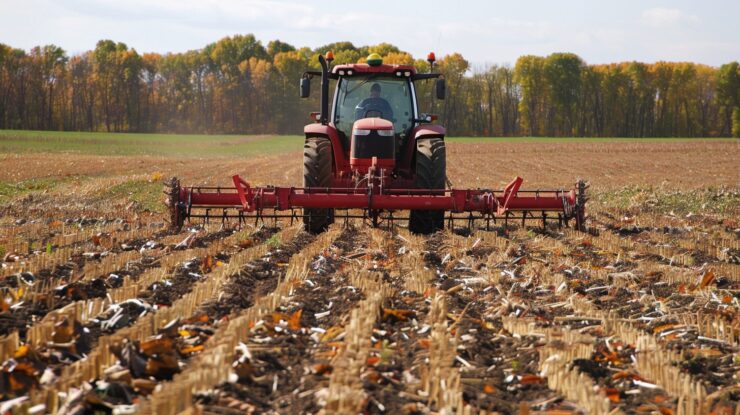Tillage practices are essential in agriculture, influencing soil health and the broader ecosystem. Traditional farming has relied heavily on conventional tillage, known for its deep plowing and soil turning. However, with increasing environmental concerns, conservation tillage has gained popularity as a sustainable option that offers benefits like reduced soil erosion, better water retention, and improved carbon sequestration.
This blog explores the differences between conventional and conservation tillage, focusing on their techniques, equipment, and effects on soil and crop yields.
Conventional Tillage: The Traditional Approach
Conventional tillage has long been the standard farming practice, involving the complete turning over of soil using plows. This method prepares the land for new plantings by disrupting the soil structure, which can lead to increased soil erosion and loss of organic matter.
- Soil Disruption: Plowing inverts the soil, bringing fresh nutrients to the surface but also increasing the risk of erosion.
- Subsequent Smoothing: After plowing, the soil is often smoothed to create an even planting surface.
- Impact on Soil Health: While effective for crop cultivation, this method can degrade soil health over time by disrupting soil microorganisms and accelerating organic matter decomposition.
Conservation Tillage: Preserving Resources
Conservation tillage is a sustainable approach that reduces the intensity of land preparation, helping to conserve soil, water, and energy. By minimizing soil disturbance and retaining crop residues, this method promotes environmental sustainability and enhances soil health.
Principles of Conservation Tillage
Conservation tillage leaves a significant amount of crop residue on the field, which helps reduce erosion and runoff. It involves minimal soil disturbance, making it a more sustainable alternative to conventional tillage.
- Soil Coverage: At least 30% of the field is covered with organic residues after planting.
- Noninversion Techniques: The soil is not turned over, which helps maintain its structural integrity.
- Depth and Disturbance: Tools are set to disturb the soil minimally while still allowing for effective seed placement.
Key Techniques in Conservation Tillage
Several specific practices fall under the conservation tillage umbrella, each designed to suit different farming needs and conditions.
- Zero-Till: Direct planting into undisturbed soil, retaining maximum residue coverage.
- Strip-Till: Only narrow strips are tilled where crops are planted, leaving the surrounding soil intact.
- Ridge-Till: Crops are planted in the valleys between ridges, which are formed from the previous crop’s residues.
- Mulch-Till: Some residue is incorporated into the soil using less invasive implements like chisels.
Implementing Conservation Tillage
Equipment and Adaptation
Adopting conservation tillage often requires specialized equipment designed to handle crop residues without extensive soil disruption.
- Specialized Planters: Devices are used that can slice through residues, placing seeds and fertilizers without turning the soil.
- Adjustments for Efficiency: Equipment may feature modifications like inverted T-type furrow openers to enhance planting efficacy.
Benefits and Challenges
While conservation tillage offers numerous environmental benefits, its adoption comes with challenges that need to be addressed through careful management and technique adaptation.
- Crop Residue Management: Managing the amount and distribution of crop residues is crucial to prevent pest issues and ensure proper seed soil contact.
- Weed and Pest Control: Strategies include the use of pre-planting non-pollutant herbicides and crop rotation to manage weeds and pests without excessive soil disturbance.
Impact on Soil and Crop Yield
Soil Health and Carbon Sequestration
Conservation tillage enhances soil health by reducing erosion and improving organic matter retention. It also promotes carbon sequestration, as less tilling means less CO2 released into the atmosphere.
- Soil Structure: Maintaining soil structure enhances water infiltration and reduces runoff.
- Organic Matter Content: Reduced tillage leads to higher organic content at the surface, fostering a healthier soil ecosystem.
Yield and Environmental Adaptation
Studies have shown varied effects on crop yields depending on environmental conditions, with some areas showing immediate improvements and others taking longer to adjust.
- Moisture Conservation: In dry areas, conservation tillage helps retain soil moisture, directly benefiting crop yields.
- Yield Stabilization: Over time, yields in wetter regions may stabilize or increase as the soil improves and adapts to the reduced tillage approach.
In summary, conservation tillage represents a shift towards more sustainable agricultural practices by focusing on soil health and resource conservation. By implementing these methods, farmers can enhance their productivity while also contributing to environmental protection.
